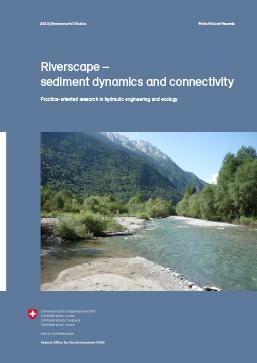Scientists gain further insight into riverscape dynamics

A section of the Rhône close to its natural state. © Michel Roggo
A compendium of research findings entitled "Riverscape – sediment dynamics and connectivity" has just been published by several Swiss research institutes. EPFL’s Platform of Hydraulic Constructions (PL-LCH) contributed to the work through two PhD theses and one postdoc study.
Riverscapes contain a mosaic of habitats, ranging from underwater ecosystems to patches of dry soil. These habitats are shaped by the hydro- and morpho-dynamic characteristics of the rivers they lie in. Two key characteristics when it comes to flood protection and ecological function during river restoration are sediment dynamics and connectivity.
A team of scientists from Switzerland’s Federal Office for the Environment (FOEN), the Swiss Federal Institute of Aquatic Science and Technology (eawag), EPFL, ETH Zurich, and the Swiss Federal Institute for Forest, Snow and Landscape Research (WSL) are helping to develop systems for restoring sediment dynamics and habitat connectivity. Their work sits at the crossroads of hydraulic engineering and river ecology. Riverscape – sediment dynamics and connectivity summarizes the scientists’ key findings, with additional contributions from researchers and experts who were not directly involved in the project.
EPFL’s Platform of Hydraulic Constructions (PL-LCH) studies featured in the compendium – two PhD theses and one postdoc study – relate to experimental approaches, mathematical modeling and in-situ measurements, as described below.
Fine sediment deposition on flood plains. Rivers extend well beyond the channels that are typically associated with this word. Of particular interest are flood plains, where important hydro- and morpho-dynamic processes occur as a result of recurrent flooding. Ecologically, flood plains also host many endangered species. This study discusses the relevant fine sediment deposition processes and presents mathematical models for forecasting fluvial responses.
Impact of substrate clogging on vertical connectivity. Connectivity between the hyporheic zone – or the region of sediment beneath and alongside a riverbed – and flowing river water is essential for the development of living organisms and the reproductive success of spawning fish. The infiltration of fine sediment leads to clogging of the riverbed, reducing porosity and vertical water exchange. The natural clogging cycle is often altered by human activity, infrastructure and land use. This PhD study includes a review of the process and influencing factors, illustrated with experimental results, and an application to specific case studies.
Sediment continuity and augmentation measures. Impaired sediment transport can have numerous adverse impacts on the eco-morpho-dynamics of the riverscape. Taking measurements of sediment augmentation can be a promising mitigation approach at different scales. This PhD study focuses on flume experiments carried out to investigate the influence of sediment augmentation on morphological bed structures and the persistence of emerging bedforms. It also includes information on design criteria and evaluation methods for outcomes.
